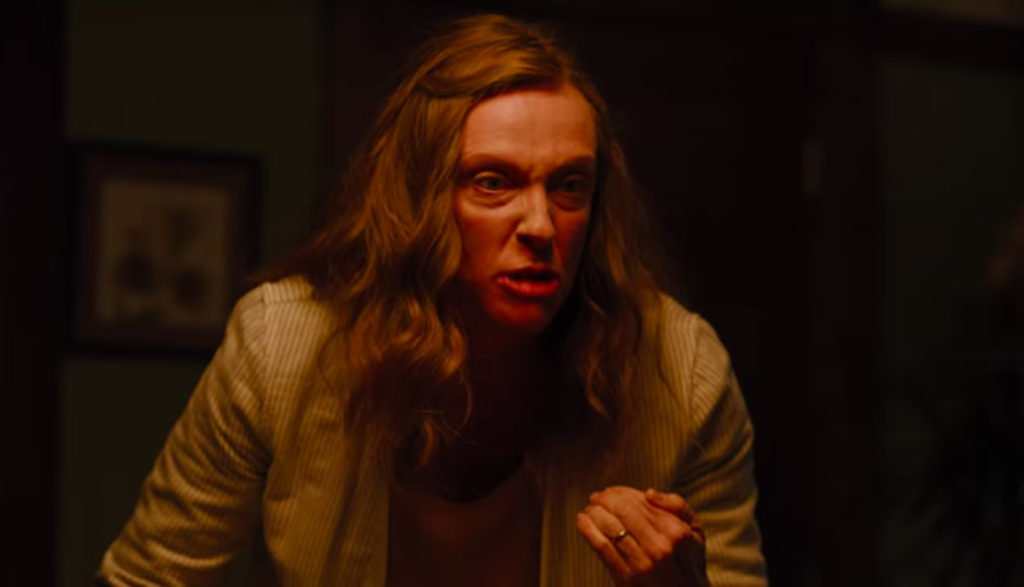
“Should I be sadder?”
That’s all Annie can muster after returning from her mother’s funeral. There is indeed a slight feeling of absence in their mountain home after her 78-year-old mother’s death. But, frankly, there’s an even bigger sense of relief.
Even in her eulogy for the woman, Annie couldn’t help but dribble out clues about how manipulative and exhaustingly difficult Ellen Leigh really was. She had driven Annie’s father to the point of killing himself from starvation, of all things. She had pushed Annie’s brother to hang himself. And then when she moved in with Annie and her husband, Steven, she started squeezing and grinding away at their lives, too. Dementia, psychosis, suicide, anguish, regret. They’re all a part of Annie’s past and present, thanks to that one terrible woman.
You can see it in Annie’s miniatures.
Annie, you see, makes small, intricate, autobiographical dioramas for a living. They’re really quite wonderful pieces of art: dramatic encapsulations of moments of life rendered in detailed miniature models.
If you look closely you’ll see so much of her mother’s corrosive influence represented there. You’ll spot how Annie kept her abrasive mother clear of their first child Peter, but, out of guilt, allowed her to sink her claws into Charlie, their daughter who came next.
Now 13, Charlie is, well, a bit abnormal. She doesn’t talk much and produces odd tongue-cluck noises on a regular basis while scribbling down drawings in a notebook or piecing together miniatures of her own from bits of discarded trash. Most people find Charlie unnerving. She just makes Annie feel … guilty.
But Peter makes Annie feel guilty too, for that matter. He’s a shaggy loner who drifts around in a daze—kept aloft by the bubbling wafts of his weed-filled bong. How much of that is due to Ellen Leigh’s presence in their lives, and Annie’s inability to keep the woman at bay?
You can see those truths and feelings represented in Annie’s art pieces. And there’s something else there, too. There’s a creepiness surrounding the dioramic miniatures of Ellen Leigh. A dark spiritual presence, if you will.
In fact, not long after the funeral, Annie was going through boxes of Ellen Leigh’s things, and she spotted strange books on spiritualism. And a note addressed to her spoke cryptically of terrible sacrifice giving birth to great reward. Annie would have sworn she even saw her mother watching her, shrouded in a shadowed corner, as Annie dug through the things. It was so horrible and shocking.
Perhaps, that’s what Annie is actually feeling these days. Not sadness or relief, but guilt, despair and, well, horror. Horror over the fact that, even while dead, this foul woman is still somehow controlling them from the grave. It’s like a curse that won’t let go. A bane that’s inevitably bound to destroy them all.
Annie’s husband, Steven, is the one person in the story who consistently tries to bring peace to this film’s dark and roiling tale. He attempts to calm and care for his wife, to dial things back when family emotions run high. And he repeatedly reaches out to Peter when he sees the teen struggling. In fact, Steven is the only one in the family who openly voices his love for the others. (Though, ultimately, the man’s efforts prove fruitless.)
Annie, on the other hand, is constantly at war with herself and those around her. But we do she her attempt to make the right choice when, on occasion, her fog of mental anguish clears.
Like a pot slowly boiling a frog alive, this film starts us off in uncomfortably warm supernatural territory, like discovered dark books of spiritualism, unnerving lights, mystic symbols and strange words scratched on an innocent’s bedroom wall. It heats all the way up to full demonic possession.
We’re ushered through seances, incantations and truly disturbing satanic rites. We learn of a person’s lifelong quest to torment and torture others as a means of giving new life to “one of the eight kings of Hell.”
People are physically possessed. The dead reappear in shrouded ghostly form or are represented by swarming insects and moving inanimate objects. A possessed person scampers along the ceiling and walls. Headless corpses are demonically reanimated. Naked cult members bow and call out their worshipful devotion to demons and the dead. Etc.
After a death in Annie’s family, someone calls to say they are in their prayers.
There is definitely some skin and dark sexuality in this story’s demonic mix. We see numerous scenes populated by totally naked cult members. The men and women are seen from every graphic angle, including from the front. Peter (as well as the camera) stares at a love interest’s jeans-covered backside.
And though breastfeeding is obviously not a sexual activity, in one unnerving scene, the camera gazes closely (but quickly) at one of Annie’s dioramas depicting Annie’s mother offering an exposed breast for baby Charlie to suckle.
Near the beginning of the film, a bird flies full speed into Charlie’s school class window, smashing itself against the glass. Later, she grabs a pair of scissors and cuts the dead bird’s head off in bloody fashion. That decapitation symbolism is repeated several times in the course of the film.
While hanging her head out of a speeding and swerving car, someone’s head is ripped off when it hits a telephone pole. We don’t see the impact, but we hear the thump and later see the severed head on the roadway, bloody, torn and covered in large ants. A desiccated, maggot-covered body is dug up from a grave and used in a satanic ritual after its head is removed. We watch a woman gorily saw her own head off with a wire garrote. A decapitated head is placed on top of a ritualistic idol.
Charlie has a nut allergy. After accidentally eating a piece of cake adorned with chopped nuts, she gasps and writhes in agony as her throat and airways slowly close.
A man is consumed by roaring flames; the camera later closely examines his smoldering, crisped flesh. While possessed, Peter repeatedly slams his own face down on his desk, shattering his bloodied nose and splitting his top lip. Another possessed person slams her head against a closed door repeatedly, too.
Annie tells vivid stories of people committing suicide and of finding the grisly remains of a loved one in her car.
Some 20 f-words pop up in dialogue as well as in the lyrics of a rap tune. Multiple uses of the s-word and “h—” show up as well. There are some 10 misuses of God’s and Jesus’ name.
A large group of high school kids drink beer and booze at a party, and Peter offers weed to a few of his friends there. They pass a bong and take hits. In fact, we see Peter light up on several occasions, both alone and with others.
Annie and Steven both pop prescription pills when the going gets rough. We see Steven throw back a glass of scotch at work.
Charlie makes small toys—mirroring her mother’s miniatures. She uses empty prescription bottles as part of her source materials.
Annie admits to her son that she never wanted to be his mother and that she tried to force her pregnant body into a miscarriage. Later, she and Peter get into a raging, heated fight over dinner. “I can’t accept and I won’t forgive, because nobody admits anything they’ve done,” the woman screams—though she herself is guilty of the same choices she rails against.
There’s a strange and disturbing schizophrenia about Hereditary. And I mean that not just in the context of its world full of fevered delusions and despair, but in relation to its very cinematic foundations. This is a movie that’s definitely of two minds, both ugly and corrosive.
The first of this pic’s twisted psyches is the story of a family—and more specifically the woman at its anguished nucleus—painfully twisted by grief and guilt. That mental-breakdown psychodrama, while involving and well-acted, has more than its share of squirming, gasping, all-too-realistic horror to drop with an unsettling tongue-cluck into your viewing lap.
But then the first scary story is cannibalized—or perhaps possessed is a better metaphor—by a second darker and even more graphically terrible one.
The things and people we initially cared about become null and void. The protagonist changes and the focus shifts. That’s when this demented construct becomes truly gruesome and obscenely demonic.
Now, if you somehow perceive the above as words of praise for this film, let me correct you. Hereditary does indeed slow-boil its way with a smothered scream away from your typical, mundane horror template. But it’s a grindingly punishing and spiritually malignant turn. And you really don’t realize how terrible it all makes you feel until the credits roll and the dreadful weight of this flick slides reluctantly off your shoulder. If, in fact, it slides off at all.


After spending more than two decades touring, directing, writing and producing for Christian theater and radio (most recently for Adventures in Odyssey, which he still contributes to), Bob joined the Plugged In staff to help us focus more heavily on video games. He is also one of our primary movie reviewers.
Our weekly newsletter will keep you in the loop on the biggest things happening in entertainment and technology. Sign up today, and we’ll send you a chapter from the new Plugged In book, Becoming a Screen-Savvy Family, that focuses on how to implement a “screentime reset” in your family!